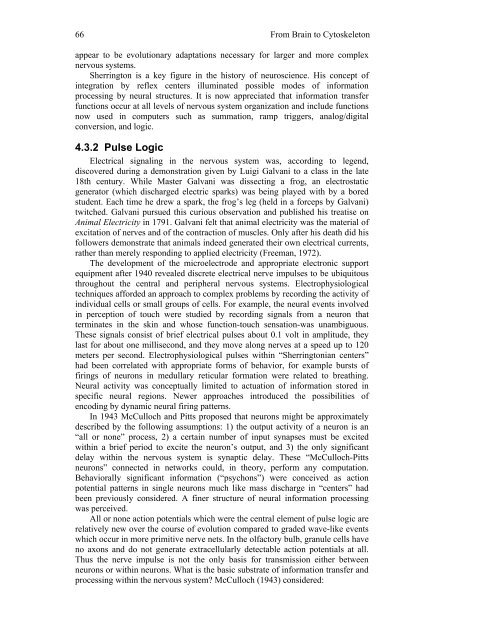ULTIMATE COMPUTING - Quantum Consciousness Studies
ULTIMATE COMPUTING - Quantum Consciousness Studies
ULTIMATE COMPUTING - Quantum Consciousness Studies
- No tags were found...
Create successful ePaper yourself
Turn your PDF publications into a flip-book with our unique Google optimized e-Paper software.
66 From Brain to Cytoskeleton<br />
appear to be evolutionary adaptations necessary for larger and more complex<br />
nervous systems.<br />
Sherrington is a key figure in the history of neuroscience. His concept of<br />
integration by reflex centers illuminated possible modes of information<br />
processing by neural structures. It is now appreciated that information transfer<br />
functions occur at all levels of nervous system organization and include functions<br />
now used in computers such as summation, ramp triggers, analog/digital<br />
conversion, and logic.<br />
4.3.2 Pulse Logic<br />
Electrical signaling in the nervous system was, according to legend,<br />
discovered during a demonstration given by Luigi Galvani to a class in the late<br />
18th century. While Master Galvani was dissecting a frog, an electrostatic<br />
generator (which discharged electric sparks) was being played with by a bored<br />
student. Each time he drew a spark, the frog’s leg (held in a forceps by Galvani)<br />
twitched. Galvani pursued this curious observation and published his treatise on<br />
Animal Electricity in 1791. Galvani felt that animal electricity was the material of<br />
excitation of nerves and of the contraction of muscles. Only after his death did his<br />
followers demonstrate that animals indeed generated their own electrical currents,<br />
rather than merely responding to applied electricity (Freeman, 1972).<br />
The development of the microelectrode and appropriate electronic support<br />
equipment after 1940 revealed discrete electrical nerve impulses to be ubiquitous<br />
throughout the central and peripheral nervous systems. Electrophysiological<br />
techniques afforded an approach to complex problems by recording the activity of<br />
individual cells or small groups of cells. For example, the neural events involved<br />
in perception of touch were studied by recording signals from a neuron that<br />
terminates in the skin and whose function-touch sensation-was unambiguous.<br />
These signals consist of brief electrical pulses about 0.1 volt in amplitude, they<br />
last for about one millisecond, and they move along nerves at a speed up to 120<br />
meters per second. Electrophysiological pulses within “Sherringtonian centers”<br />
had been correlated with appropriate forms of behavior, for example bursts of<br />
firings of neurons in medullary reticular formation were related to breathing.<br />
Neural activity was conceptually limited to actuation of information stored in<br />
specific neural regions. Newer approaches introduced the possibilities of<br />
encoding by dynamic neural firing patterns.<br />
In 1943 McCulloch and Pitts proposed that neurons might be approximately<br />
described by the following assumptions: 1) the output activity of a neuron is an<br />
“all or none” process, 2) a certain number of input synapses must be excited<br />
within a brief period to excite the neuron’s output, and 3) the only significant<br />
delay within the nervous system is synaptic delay. These “McCulloch-Pitts<br />
neurons” connected in networks could, in theory, perform any computation.<br />
Behaviorally significant information (“psychons”) were conceived as action<br />
potential patterns in single neurons much like mass discharge in “centers” had<br />
been previously considered. A finer structure of neural information processing<br />
was perceived.<br />
All or none action potentials which were the central element of pulse logic are<br />
relatively new over the course of evolution compared to graded wave-like events<br />
which occur in more primitive nerve nets. In the olfactory bulb, granule cells have<br />
no axons and do not generate extracellularly detectable action potentials at all.<br />
Thus the nerve impulse is not the only basis for transmission either between<br />
neurons or within neurons. What is the basic substrate of information transfer and<br />
processing within the nervous system McCulloch (1943) considered:






